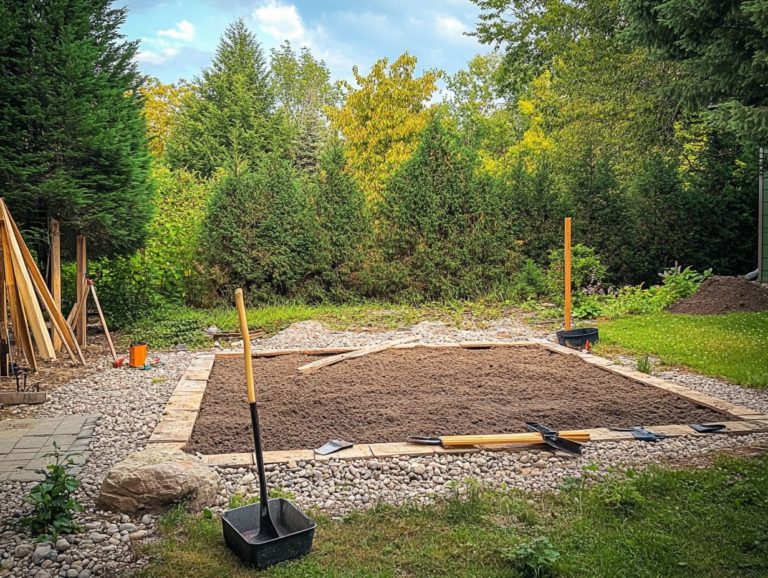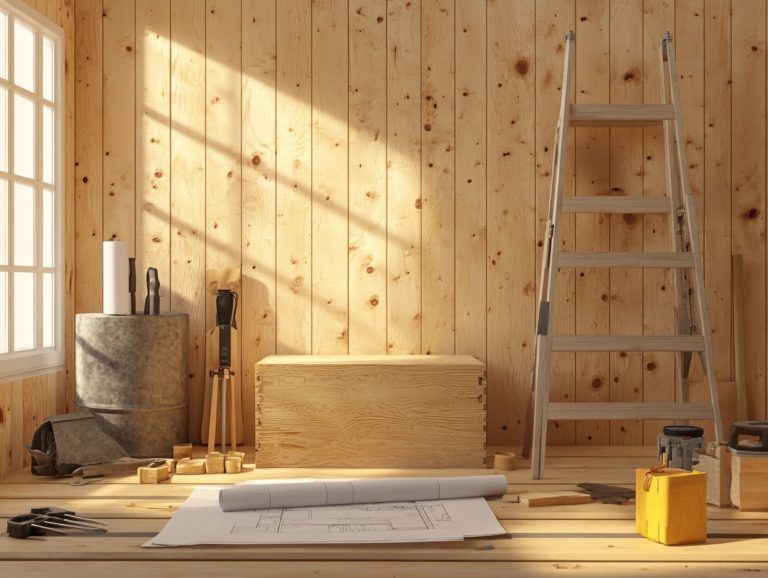“How to Build a DIY Sauna for Your Wellness Journey”
Creating your own DIY sauna can be a rewarding enhancement to your wellness journey. It brings many health benefits, from deep relaxation to improved circulation.
Saunas are fantastic for your well-being. Understanding the building materials and tools required for construction is crucial for success.
This guide provides a step-by-step approach to building your own sauna. It also offers invaluable tips for usage and sauna techniques maintenance.
We will also explore different sauna options, including traditional saunas and infrared saunas, ensuring you find the perfect fit for your lifestyle.
Prepare to transform your home into a personal retreat!
Contents
- Key Takeaways:
- The Benefits of a DIY Sauna
- Materials and Tools Needed
- Step-by-Step Guide to Building a DIY Sauna
- Tips for Using and Maintaining Your Sauna
- Alternative Sauna Options
- Frequently Asked Questions About DIY Saunas
- What are the benefits of building a DIY sauna for my wellness journey?
- Do I need special skills or tools to build a DIY sauna?
- What materials do I need to build a DIY sauna?
- How much space do I need to build a DIY sauna?
- Can I customize my DIY sauna?
- Are there safety precautions for building a DIY sauna?
Key Takeaways:

- Saunas offer a wide range of health benefits, such as improving circulation and reducing stress.
- Building a DIY sauna requires basic materials and tools, making it an accessible project for anyone interested in creating their own wellness retreat at home.
- Proper maintenance and use of your sauna maximize comfort and longevity. There are alternative sauna options, such as steam rooms and outdoor saunas, for those looking for a different experience.
The Benefits of a DIY Sauna
Creating a DIY sauna can elevate your lifestyle. It offers many health benefits while transforming your home into a serene retreat that feels like a traditional sauna.
Imagine the comforting embrace of cedar wood and the unique experience it provides. You can enjoy the therapeutic rewards of heat therapy, which is the use of heat to relieve pain and promote relaxation, right in your own backyard or home.
Whether you want to relax, detox, or just enjoy peace, a DIY sauna can help. Undertaking a well-crafted sauna project can be fulfilling and enhance your wellness routine.
Why Saunas are Good for Your Health
Saunas, whether you prefer traditional methods or infrared technology, provide remarkable health benefits. They significantly enhance your overall well-being and relaxation.
This ancient practice boosts circulation, helping you feel revitalized and energized. It also aids in muscle recovery after a rigorous workout. The warmth of a Finnish sauna, often heated by a wood-burning stove, encourages detoxification through sweat, which can lower your stress levels.
On the other hand, infrared saunas use electric heaters to penetrate deeper into your skin. This provides targeted relief, perfect for anyone seeking therapy for conditions like arthritis. Each method has unique advantages, making it vital to choose the one that aligns with your specific health goals for maximum benefits.
Materials and Tools Needed
Embarking on a DIY sauna project is an exciting venture. Selecting the right materials and tools is crucial to ensure durability and a superb sauna experience, whether you prefer a traditional aesthetic or an innovative sauna kit.
From cedar wood to insulation materials, every building material you choose contributes to the sauna’s effectiveness and longevity.
Don’t overlook the importance of a proper ventilation system; it’s essential for maintaining air quality and comfort. Carefully considering your tools and materials is a pivotal step in your sauna construction journey, along with following tips for maintaining your sauna’s exterior.
Essential Supplies for Building a Sauna

When you’re constructing your DIY sauna, gather a few essential supplies. A quality sauna heater is key for effective temperature regulation. A sturdy sauna door enhances energy efficiency.
Beyond these crucial items, pay attention to insulation materials. Choosing the right insulation helps maintain heat levels while keeping your energy costs in check. Accessories like benches and interior lighting boost comfort and elevate aesthetics, creating a relaxing ambiance for you and your guests.
Don t underestimate the importance of proper electrical wiring; it s vital for both safety and functionality. This enables efficient operation of the heater and any additional electrical features you might want.
Including a thermometer and hygrometer will aid in monitoring the sauna environment. A hygrometer measures humidity levels, ensuring you enjoy the perfect experience each time you step inside.
Step-by-Step Guide to Building a DIY Sauna
Building your own sauna is a fun and rewarding project! You ll want to maximize your floor space while considering the capacity necessary for an enjoyable sauna experience.
This guide walks you through every important step of the construction process, from selecting the right building materials to crafting a comfortable, functional space. Whether you choose a traditional sauna or a sleek modern infrared design, you’ll find everything you need to create your perfect retreat. Remember to prioritize sauna safety with regular checks to ensure a secure environment.
Instructions for Construction
The construction of your DIY sauna involves several critical steps, including framing, insulation, and electrical wiring installation. Each of these elements is essential for performance and safety.
As you progress through each phase, careful attention to detail is crucial. This ensures your sauna operates efficiently while adhering to safety standards. When framing, make sure to select moisture-resistant materials; the humid environment can compromise regular wood over time.
For insulation, opt for high-quality materials like fiberglass or mineral wool. These provide exceptional thermal performance, meaning they keep heat in effectively.
Use correctly rated electrical wiring and fixtures. Knowing the local rules will enhance safety and improve the sauna’s overall functionality. If you’re uncertain about handling electrical aspects, consult a licensed electrician. Additionally, be aware of troubleshooting common sauna issues to prevent potential hazards and ensure that your sauna is safe and enjoyable.
Tips for Using and Maintaining Your Sauna
To truly savor your DIY sauna experience, embrace effective strategies for both usage and maintenance. This ensures you enjoy maximum comfort and longevity.
Familiarize yourself with various sauna techniques and consider handy accessories to elevate your sessions. Ensure proper ventilation and care to keep your sauna in great shape for years to come.
Maximizing Comfort and Longevity

To truly maximize your comfort during a sauna experience, consider incorporating an array of sauna techniques, essential oils, and thoughtfully selected accessories. These enhance relaxation and therapeutic benefits. This approach makes each sauna session more enjoyable and effective.
Stay hydrated! Drinking water or herbal teas before stepping into the sauna prepares your body for the heat. Timing holds equal importance; spending about 15-20 minutes in the sauna creates the ideal environment for detoxification and muscle recovery. For best results, follow the steps for proper sauna installation maintenance.
To further enrich your experience, heated sauna rocks create a soothing ambiance. Also, birch twigs add a unique sensory element and can be used for a gentle massage that stimulates circulation. For optimal performance, understanding sauna insulation and maintenance is key. Integrating essential oils like eucalyptus or lavender transforms the atmosphere into a tranquil sanctuary, maximizing your relaxation and rejuvenation.
Alternative Sauna Options
Exploring alternative sauna options can enhance your appreciation for the diverse experiences available. Consider infrared saunas, traditional steam rooms, and outdoor saunas. Each option has unique benefits tailored to your preferences.
Embracing these alternatives allows you to discover what resonates with your wellness journey.
Comparing Different Types of Saunas
When comparing sauna types, consider factors like temperature, humidity, and overall experience. Each type offers unique advantages for your needs.
Traditional saunas are heated between 150 to 195 degrees Fahrenheit. They create dry heat that many enthusiasts love for relaxation.
If you’re looking for a therapeutic experience, infrared saunas use technology to penetrate deeper into the skin. They typically operate at lower temperatures of 120 to 140 degrees Fahrenheit.
Steam rooms provide a high-humidity environment that promotes hydration. This is ideal for those seeking relief from allergies or sinus congestion.
Each sauna option offers varied experiences and health benefits, such as detoxification, muscle relief, and improved circulation. There s something for everyone!
Frequently Asked Questions About DIY Saunas
What are the benefits of building a DIY sauna for my wellness journey?

Building a DIY sauna can improve circulation, relieve stress, and aid detoxification.
Do I need special skills or tools to build a DIY sauna?
No! Building a DIY sauna is straightforward. Basic carpentry skills and tools like a drill and saw are usually sufficient.
What materials do I need to build a DIY sauna?
Materials for your DIY sauna depend on your design but typically include wood, insulation, and a heat source. Common choices are cedar wood, poplar, and hemlock.
How much space do I need to build a DIY sauna?
The sauna’s size relies on your preference and available space. A small sauna can fit in an area as small as 2 feet by 2 feet, while larger saunas may need a dedicated room.
Can I customize my DIY sauna?
Yes! Building your sauna allows for customization. You can choose the size, materials, and features that suit your needs.
Are there safety precautions for building a DIY sauna?
Yes, follow safety guidelines. Ensure proper ventilation and use appropriate materials for your heat source. Consult a professional if you have any concerns.






